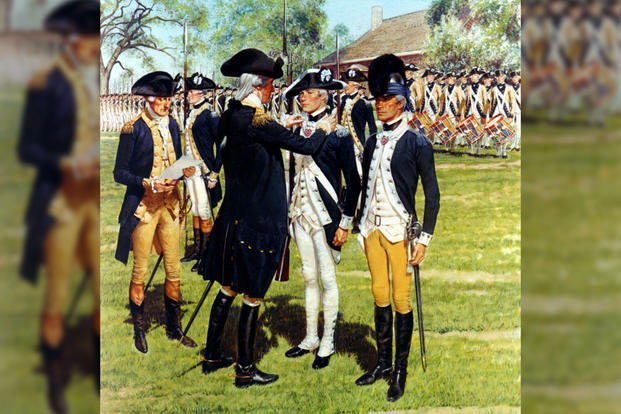The decoration that would become known as the Purple Heart was awarded less than a year after Gen. George Washington designed it in 1782. Established as the Badge of Military Merit, it went first to 26-year-old Sgt. Elijah Churchill, a member of the 4th Troop, Second Continental Dragoons. Churchill had enlisted in Enfield, Connecticut, and was part of the force that attacked Fort St. George on New York's Long Island on Nov. 21, 1780.
Under the command of Maj. Benjamin Tallmadge, Churchill led an attack party against the supply depot, which was surrounded by 12-foot-high stockades. Shouting "Washington and Glory!" the men stormed the redoubt and quickly took the fort. Eleven months later, Churchill was wounded while leading a whaleboat raid against Fort Slongo (or Salonga) on Oct. 2, 1781. His men destroyed artillery and ammunition and took 21 prisoners in the successful action.
For these two incidents, Churchill was presented with a heart-shaped purple badge embroidered with the word "Merit" on May 3, 1783. (Fellow Connecticut native Sgt. William Brown also received an award.) Churchill's award citation noted "that at the head of each body of attack he not only acquitted himself with great gallantry, firmness, and address; but that the surprise in one instance, and the success of the attack in the other, proceeded in a considerable degree from his conduct and management."
Washington had designed the award nine months earlier, on Aug. 7, 1782, at his Newburgh, N.Y., headquarters. The "figure of a heart in purple cloth or silk edged with narrow lace or binding" was to be awarded for "any singularly meritorious action." In his orderly book, he wrote, "The road to glory in patriot army and a free country is thus open to all. This order is also to have retrospect to the earliest stages of the war, and to be considered a permanent one."
Only three of the awards were given. (The third, in 1783, went to Sgt. Daniel Bissell, another Nutmeg State native). But on Feb. 22, 1932, the bicentennial of Washington's birth, the Badge of Military Merit was redesigned and reissued as the Purple Heart. President Herbert Hoover's instructions read that the Purple Heart was to be given for "any singularly meritorious act of extraordinary fidelity or essential service. A wound received in action may be construed as resulting from such an act."
Want to Know More About the Military?
Be sure to get the latest news about the U.S. military, as well as critical info about how to join and all the benefits of service. Subscribe to Military.com and receive customized updates delivered straight to your inbox.















